The Third Secret Controversy—Part VI
The Suppression of the Third Secret
Some very critical things have been said about Pope
Pius XII by certain authors, accusing him, for instance, of aiding the suppression of the
Third Secret by ordering all the Fatima documents to be sent to Rome in 1957.
However, there is no hard evidence that this was done to suppress the Secret. There
were repeated indications during the time of Pope Pius XII that the Third Secret would
indeed be revealed in 1960. Again, some have criticized Pope Pius XII because, they
say, he did not read the Secret when invited to do so by Sister Lucia. But there is
no hard evidence for this assumption either. The fact that it has been reported that
the envelope (or one of them) was still sealed after the death of Pope Pius XII proves
nothing. Even wax seals are easily resealed, and it would have been imprudent to
leave such envelopes unsealed.
All the hard evidence concerning the suppression of
the Secret points to one person: John XXIII. To understand clearly the history of
the suppression, however, one must look to an event which occurred near the end of the
Pontificate of Pope Pius XII. This was the publication of an interview conducted by
Fr. Augustín Fuentes with Sister Lucia. Fr. Fuentes was the
postulator of the cause of the beatification of the Fatima visionaries, Francisco and
Jacinta Marto. He spoke with Lucia on the day after Christmas of 1957. The
conversation was published, with ecclesiastical approval, in the United States in 1958 in
the magazine, Fatima Findings, and again on June 22, 1959, in the Portuguese daily,
A Voz. Poor Fr. Fuentes was to pay dearly for his zeal. Let us see what
it was that occasioned such a firestorm of reaction after the death of Pope Pius XII.
Sr. Lucia's Interview with Fr. Fuentes, Dec. 26, 1957
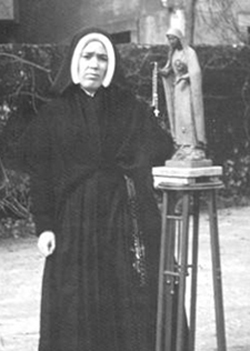 It should be noted that this interview took
place only three weeks after the death of Bishop da Silva on Dec. 4, 1957. It is
easy to understand that Sr. Lucia was very much saddened, not only by the death of her
Bishop, but by his apparent failure to read the Third Secret, in spite of her urgings to
do so. But her anxiety obviously goes much further than that. We have already
given an excerpt from this text in the first part of this series. Here is the entire
text, with Fr. Fuentes giving his comments in italics:
It should be noted that this interview took
place only three weeks after the death of Bishop da Silva on Dec. 4, 1957. It is
easy to understand that Sr. Lucia was very much saddened, not only by the death of her
Bishop, but by his apparent failure to read the Third Secret, in spite of her urgings to
do so. But her anxiety obviously goes much further than that. We have already
given an excerpt from this text in the first part of this series. Here is the entire
text, with Fr. Fuentes giving his comments in italics:
"I wish only to tell you about the last
conversation which I had with Sister Lucia on the 26th of December last year. I met
her in her convent. She was very sad, very pale and emaciated. She said to me:
"Father, the Most Holy Virgin is very sad
because no one has paid any attention to Her message, neither the good nor the bad.
The good continue on their way but without giving any importance to Her message.
The bad, not seeing the punishment of God actually falling upon them, continue their life
of sin without even caring about the message. But believe me, Father, God will
chastise the world and this will be in a terrible manner. The punishment from Heaven
is imminent.
"Father, how much time is there before 1960
arrives? It will be very sad for everyone, not one person will rejoice at all if
beforehand the world does not pray and do penance. I am not able to give any other
details because it is still a secret. According to the will of the Most Holy Virgin,
only the Holy Father and the Bishop of Fatima are permitted to know the Secret, but they
have chosen not to know it so that they would not be influenced.
"This is the third part of the Message of Our
Lady, which will remain secret until 1960.
"Tell them, Father, that many times the most
Holy Virgin told my cousins Francisco and Jacinta, as well as myself, that many nations
will disappear from the face of the earth. She said that Russia will be the
instrument of chastisement chosen by Heaven to punish the whole world if we do not
beforehand obtain the conversion of that poor nation..."
"Sister Lucia also told me: Father, the
devil is in the mood for engaging in a decisive battle against the Blessed Virgin.
And the devil knows what it is that most offends God and which in a short space of time
will gain for him the greatest number of souls. Thus, the devil does everything to
overcome souls consecrated to God, because in this way, the devil will succeed in leaving
the souls of the faithful abandoned by their leaders, thereby the more easily will he
seize them.
"That which afflicts the Immaculate
Heart of Mary and the Heart of Jesus is the fall of religious and priestly souls.
The devil knows that religious and priests who fall away from their beautiful vocation
drag numerous souls to Hell. ...The devil wishes to take possession of consecrated
souls. He tries to corrupt them in order to lull to sleep the souls of lay people
and thereby lead them to final impenitence. He employs all tricks, even going so far
as to suggest the delay of entrance into religious life. Resulting from this is the
sterility of the interior life, and among laypeople, coldness (lack of enthusiasm)
regarding the subject of renouncing pleasures and the total dedication of themselves to
God.
"Tell them also, Father, that my cousins
Francisco and Jacinta sacrificed themselves because in all the apparitions of the Most
Holy Virgin, they always saw Her very sad. She never smiled at us. This
sadness, this anguish which we noted in Her, penetrated our souls. This sadness is
caused by the offenses against God and the punishments which menace sinners. And so,
we children did not know what to think except to invent various means of praying and
making sacrifices...
"The other thing which sanctified my cousins
was to see the vision of Hell.
"Father, that is why my mission is not to
indicate to the world the material punishments which are certain to come if the world does
not pray and do penance beforehand. No! My mission is to indicate to each one
of us the imminent danger we are in of losing our immortal souls for all eternity if we
remain obstinate in sin."
"Sister Lucia also said to me: Father,
we should not wait for an appeal to the world to come from Rome on the part of the Holy
Father, to do penance. Nor should we wait for the call to penance to come from our
bishops in our diocese, nor from the religious congregations. No! Our Lord has
already very often used these means, and the world has not paid attention. That is
why now it is necessary for each one of us to begin to reform himself spiritually.
Each person must not only save his own soul but also help all the souls that God has
placed on our path...
"The Devil does all in his power to distract us
and to take away from us the love for prayer...
"Father, the Most Holy Virgin did not tell me
that we are in the last times of the world, but She made me understand this for three
reasons.
"The first reason is because She told me that
the Devil is in the mood for engaging in a decisive battle against the Virgin. And a
decisive battle is the final battle where one side will be victorious and the other side
will suffer defeat. Also from now on we must choose sides. Either we are for
God or we are for the Devil. There is no other possibility.
"The second reason is because She said to my
cousins as well as to myself that God is giving two last remedies to the world.
These are the Holy Rosary and devotion to the Immaculate Heart of Mary. These are
the last two remedies, which signify that there will not be others.
"The third reason is because in the plans of
Divine Providence God always, before He is about to punish the world, exhausts all other
remedies. Now, when He sees that the world pays no attention whatsoever, then, as we
say in our imperfect manner of speaking, He offers us 'with a certain
trepidation' the last means of salvation, His Most Holy Mother. It is
'with a certain trepidation' because if you despise and repulse this ultimate
means we will not have any more forgiveness from Heaven because we will have committed a
sin which the Gospel calls the sin against the Holy Ghost. This sin consists of
openly rejecting with full knowledge and consent, the salvation which He offers. Let
us remember that Jesus Christ is a very good Son and that He does not permit that we
offend and despise His Most Holy Mother. We have recorded through many centuries of
Church history the obvious testimony which demonstrates, by the terrible chastisements
which have befallen those who have attacked the honor of His Most Holy Mother, how Our
Lord has always defended the honor of His Mother."
"Sister Lucia told me: The two means to
save the world are prayer and sacrifice.
"Regarding the Holy Rosary, Sister Lucia
said: Look, Father, the Most Holy Virgin, in these last times in which we live, has
given a new efficacy to the recitation of the Holy Rosary. She has given this
efficacy to such an extent that there is no problem, no matter how difficult it is,
whether temporal or above all, spiritual, in the personal life of each one of us, of our
families, of the families of the world, or of the religious communities, or even of the
life of peoples and nations that we cannot resolve through the recitation of the Rosary.
There is no problem, I tell you, no matter how difficult it is, that we cannot
resolve by the prayer of the Holy Rosary. With the Holy Rosary we will save
ourselves. We will sanctify ourselves. We will console Our Lord and obtain the
salvation of many souls.
"Finally, devotion to the Immaculate Heart of
Mary, Our Most Holy Mother, consists in considering Her as the seat of mercy, goodness and
pardon and as the sure door through which we are to enter Heaven." (La Verdad
sobre el Secreto de Fatima, Fr. Joaquín Alonso).
The Chastising of Fr. Fuentes
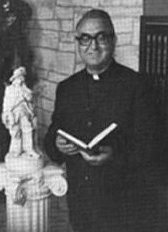 Between the first publication of this
interview in Fatima Findings, and the second in A Voz, Pope Pius XII had
died and John XXIII had begun his plans for Vatican Council II—the council of
"no condemnations." Nevertheless, on July 2, 1959, the Chancery of Coimbra
published an extremely harsh, but anonymous, condemnation of Fr. Fuentes:
Between the first publication of this
interview in Fatima Findings, and the second in A Voz, Pope Pius XII had
died and John XXIII had begun his plans for Vatican Council II—the council of
"no condemnations." Nevertheless, on July 2, 1959, the Chancery of Coimbra
published an extremely harsh, but anonymous, condemnation of Fr. Fuentes:
Father Augustín Fuentes, postulator of the cause of beatification for the seers of Fatima, Francisco and
Jacinta, visited Sister Lucia at the Carmel of Coimbra and spoke to her exclusively about
things concerning the process in question. But after returning to Mexico, his
country—if we can believe an article in A Voz of last June 22, and a
translation by M. C. de Bragança published on July 1 by the same
journal—this priest allowed himself to make sensational declarations, of an
apocalyptic, eschatological and prophetic character, which he declares that he heard from
Sister Lucia's very lips.
Given the gravity of such statements, the chancery
of Coimbra believed it its duty to order a rigorous investigation on the authenticity of
such news which persons too avid for the extraordinary have spread in Mexico, in the
United States, in Spain, and finally in Portugal.
For the peace of mind of those who have read the
documentation published in A Voz and have taken alarm at the thought of fearful
cataclysms which, according to such documentation, are to come upon the world in 1960, and
still more, in order to put an end to the biased campaign of "prophecies," whose
authors, perhaps without realizing it, are provoking a storm of ridicule, not only where
they themselves are concerned, but also with regard to things reported as having been said
by Sister Lucia, the Diocese of Coimbra has decided to publish these words of Sister
Lucia, given in answer to questions put by one who has the right to do so:
"Father Fuentes spoke to me in his capacity as
Postulator for the causes of beatification of the servants of God, Jacinta and Francisco
Marto. We spoke solely of things connected with this subject; therefore, whatever
else he refers to is neither exact nor true. I am sorry about it, for I do not
understand what good can be done for souls when it is not based on God, Who is the Truth.
I know nothing, and could therefore say nothing, about such punishments, which are
falsely attributed to me."
The chancery of Coimbra is in a position to declare
that since up to the present Sister Lucia has said everything she believed it her duty to
say about Fatima, she has said nothing new and consequently has authorized nobody, at
least since February 1955, to publish anything new that might be attributed to her on the
subject of Fatima."
Fr. Fuentes was literally being accused of lying,
and Sr. Lucia appeared to be confirming the accusation! But Fr. Fuentes was not
without his defenders. Archbishop Manuel Lopez of Veracruz maintained that Fr.
Fuentes "had preached nothing that would contradict the message of Fatima, nor had he
attributed frightening prophecies to Sr. Lucia." The Archbishop of Guadalajara,
Cardinal José Garibi y Rivera, also insisted that Fr. Fuentes
"had predicted nothing terrible in his preachings." Indeed the text quoted
above, while it contains serious warnings, makes no specific prophecies. Sr. Lucia
merely reminds us that the "punishment from Heaven is imminent" and lists the
reasons for which she believes we are in the "last times." So what was the
Chancery of Coimbra referring to?
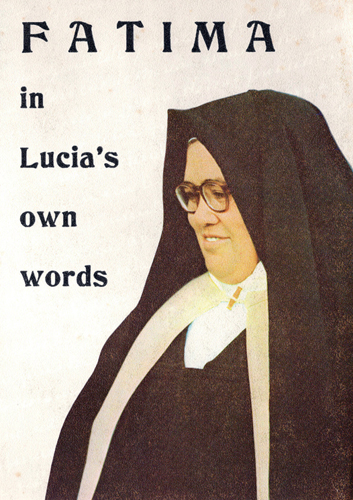
Fr. Fuentes was replaced
as postulator by Fr. Louis Kondor, who reportedly took this photo of Sr. Lucia
for the cover of her soon-to-be-published memoirs in April, 1963 -- less than 5½ years
after Fr. Fuentes
described her as "sad, very pale and emaciated."
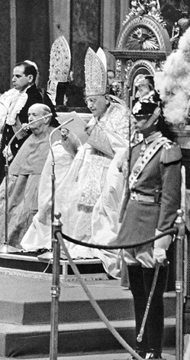 In spite of the efforts of his defenders, Fr. Fuentes was soon relieved of his functions as postulator for
the cause of beatification for Francisco and Jacinta Marto, a decision which surely had to
have come from John XXIII. After all was not Fr. Fuentes—and Sr. Lucia for that
matter (and Our Lady of Fatima Herself)—amongst the "prophets of
doom" that John XXIII had denounced at the opening of Vatican II (see photo
right)? There he had said, on October 11, 1962:
In spite of the efforts of his defenders, Fr. Fuentes was soon relieved of his functions as postulator for
the cause of beatification for Francisco and Jacinta Marto, a decision which surely had to
have come from John XXIII. After all was not Fr. Fuentes—and Sr. Lucia for that
matter (and Our Lady of Fatima Herself)—amongst the "prophets of
doom" that John XXIII had denounced at the opening of Vatican II (see photo
right)? There he had said, on October 11, 1962:
In the daily exercise of our pastoral office, we
often have to listen, with sad ears, to the voices of persons who, though burning with
zeal, are not overly endowed with a sense of discretion or judgment. In these
modern times they see nothing but calamity and ruin. They say constantly that our
era, in comparison with the past, is growing steadily worse; they behave as if they have
learned nothing from history, the teacher of life. They act as if former councils
were evidence of complete victories for the Christian ideal of life and for true religious
liberty. We, however, are of a completely different opinion from those prophets of
doom who are always forecasting disaster as though the end of the world were at
hand. In the present development of human events, through which mankind appears to
be entering a new order, one must, rather, discern a hidden plan of Divine
Providence...
The truth about this shocking event would not come
out until 1976. But he who revealed the truth would also pay a price.
Fr. Alonso—the Fatima Archivist
Fr. Joaquín Alonso had been
entrusted by Bishop da Silva's successor, Monsignor Venancio, with the task of
archiving and editing all of the documents concerning Fatima. Early on he had
adopted the criticism of the Chancery of Coimbra concerning Fr. Fuentes. But by
1975, and after much painstaking research, he had completely reversed his opinion.
In his work, published in English in 1976 as The Secret of Fatima: Fact and Legend,
he tactfully revealed the truth:
Who was right in this lamentable affair?
Father Fuentes, the Coimbra diocesan spokesman, or Lucia? We would like to offer an
explanation, giving our own modest opinion:
1. What Father Fuentes says in the genuine text of
his conference to the Mexican religious community... (in May of 1958) corresponds
no doubt in its essentials to what he heard during his visit to Sister Lucia, for
although the text is mingled with the preacher's own oratorical embellishments, and
although it is adjusted to conform to a literary pattern, these texts say nothing that
Sister Lucia had not said in her numerous published writings. Perhaps the
principle defect lay in the presentation of these texts as coming from Lucia's own
mouth, and formally and expressly given as "a message from her" addressed to the
world. Sister Lucia did not have this intention.
2. The genuine text, the only one that can be
justly attributed to Father Fuentes, does not, in my opinion, contain anything
that could give rise to the condemnatory notice issued from Coimbra. On the
contrary, it contains a teaching most suited to edify the piety of Christians.
3. The diocese of Coimbra, and through it Sister
Lucia, have made no distinction between the genuine text which alone can be justly
attributed to Father Fuentes, and the vast "documentation" to which we have
already referred. An error of judgment was thus committed, for everything was included
in one single all-embracing condemnation.
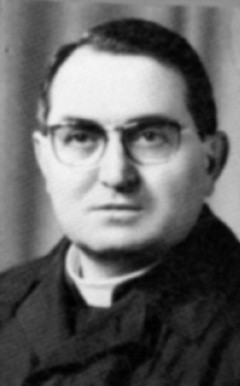 In other
words, Fr. Alonso was tactfully suggesting that Sister Lucia was shown some false
documents (probably articles from the journal A Voz) which led to her statement of
denial, if indeed the statement is even genuine. In the same work Fr. Alonso also
gave his opinion on the probable contents of the Third Secret:
In other
words, Fr. Alonso was tactfully suggesting that Sister Lucia was shown some false
documents (probably articles from the journal A Voz) which led to her statement of
denial, if indeed the statement is even genuine. In the same work Fr. Alonso also
gave his opinion on the probable contents of the Third Secret:
If 'in Portugal the dogma of the Faith will
always be preserved,' ...it can be clearly deduced from this that in other parts of
the Church these dogmas are going to become obscure or even lost altogether.
Thus it is quite possible that in this intermediate
period which is in question (after 1960 and before the triumph of the Immaculate Heart of
Mary), ...the text makes concrete references to the crisis of the Faith within the Church
and to the negligence of the pastors themselves,... [to] ...internal struggles
in the very bosom of the Church and of grave pastoral negligence by the upper
hierarchy,... [and] ...deficiencies of the upper hierarchy of the Church.
Could Fr. Alonso have been referring to John XXIII
and Vatican II? By this time Fr. Alonso had also finished his massive work, Fatima
Texts and Critical Studies, consisting of 24 volumes of some 800 pages each. He
referenced and archived 5,396 documents in this result of his ten years of research.
However, the "upper hierarchy" would not let such criticism go by
unnoticed. The new "bishop" of Leiria-Fatima, Alberto do Amaral, forbade
the publication of the 24 volumes entirely! It was only after the death of Fr.
Alonso, that two highly edited volumes were published. Apparently silencing the
Third Secret itself was not enough.
Roncalli vs. Our Lady of Fatima
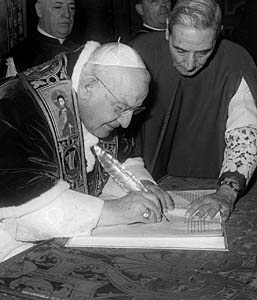 Msgr. Capovilla, who has provided the best
evidence for the existence of a second text of the Third Secret, has also provided us with
a blow-by-blow account of the decision of John XXIII to suppress the Secret. On
October 28, 1958—less than three weeks after the death of Pope Pius XII—Sr.
Lucia, perhaps fearing what was to come, put aside her usual reserve and asked for
permission to deliver a radio message to the world! In early January of 1959, a
meeting was held to discuss this and the Third Secret. Cardinal Cento, who had
brought the Third Secret to Rome in 1957, told Roncalli: "It is well that you take a
look at it. Sr. Lucia has approached me. She could deliver a message to the
world. I do not know if it is opportune..." Roncalli's answer:
there would be no radio message; instead great restrictions were to be placed on the
communications of Sr. Lucia. Eventually she was not permitted to speak to anyone
(with very few exceptions) without the Vatican's permission.
Msgr. Capovilla, who has provided the best
evidence for the existence of a second text of the Third Secret, has also provided us with
a blow-by-blow account of the decision of John XXIII to suppress the Secret. On
October 28, 1958—less than three weeks after the death of Pope Pius XII—Sr.
Lucia, perhaps fearing what was to come, put aside her usual reserve and asked for
permission to deliver a radio message to the world! In early January of 1959, a
meeting was held to discuss this and the Third Secret. Cardinal Cento, who had
brought the Third Secret to Rome in 1957, told Roncalli: "It is well that you take a
look at it. Sr. Lucia has approached me. She could deliver a message to the
world. I do not know if it is opportune..." Roncalli's answer:
there would be no radio message; instead great restrictions were to be placed on the
communications of Sr. Lucia. Eventually she was not permitted to speak to anyone
(with very few exceptions) without the Vatican's permission.
On January 25, 1959, John XXIII was
again advised to read the Third Secret immediately. But he decided to wait until he
had announced the convocation of Vatican II (see photo left). Did he
perhaps fear that the Third Secret contained a warning about the very thing he was
determined to do? It was not until August 17 that he would read the Secret.
Capovilla gives the details: "[John XXIII] after having spoken with everyone [the
collaborators he had consulted] told me: 'Write.' And I wrote under his
dictation: 'The Holy Father had received from the hand of Msgr. Phillipe this
writing. It was decided to read it on Friday with his confessor. There being
abstruse locutions, he called for Msgr. Tavares, who translated. He allowed his most
intimate collaborators to see it. It was finally decided to reseal the envelope with
this phrase: I do not give any judgment.' Silence before something that
could or could not be a manifestation of the divine."
There followed, on February 8, 1960, the anonymous
press release, from which we have already quoted in the first part of this Series.
It would be good to recall here these words of the press release: "It is very
probable that the letter in which Sr. Lucia wrote the words of the Virgin Mary
addressed to the three shepherds at the Cova da Iria, will never be opened."
After all that we have seen in this Series, these words become a glaring
contradiction—for the "vision text" published in 2000 is not a letter and
it contains no words of the Virgin Mary!
It is also worth noting
that, at Vatican II, John XXIII invited two Russian Orthodox observers to be present, with
the assurance that the Council would not formulate any condemnation of Communism or the
Soviet system. "The initiative for the meetings (to make this unholy accord)
was taken personally by John XXIII at the suggestion of Cardinal Montini..." (Roman
Amerio, Iota Unum, 1985). After the silencing of Sr. Lucia and Our Lady of
Fatima, who warned specifically that "Russia would spread her errors...",
this action of Roncalli and Montini is seen to be all the more deliberate—and
sinister.
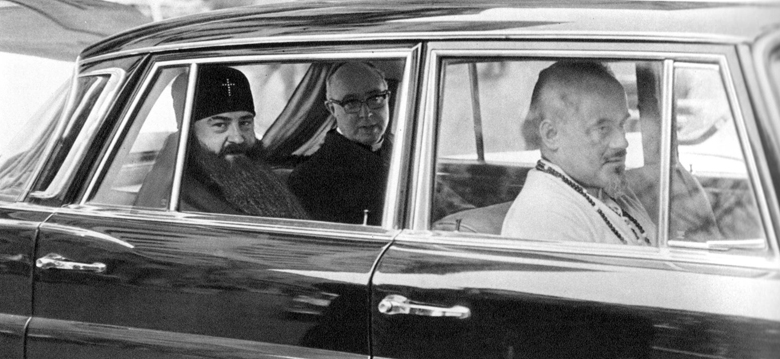
There having been no condemnation of
Communism or the Soviet system -- in accordance with the
assurance made by John XXIII and the future Paul VI -- Russian Orthodox
"Metropolitan" Nikodim
arrives in Rome with John XXIII's agent, Msgr. Willebrands, and Fr. Pierre Duprey from the
"Secratariat for Christian Unity," for the last day of Vatican II.
Back to "In this Issue"
Back to Top
Contact us: smr@salvemariaregina.info
Visit also: www.marienfried.com


 It should be noted that this interview took
place only three weeks after the death of Bishop da Silva on Dec. 4, 1957. It is
easy to understand that Sr. Lucia was very much saddened, not only by the death of her
Bishop, but by his apparent failure to read the Third Secret, in spite of her urgings to
do so. But her anxiety obviously goes much further than that. We have already
given an excerpt from this text in the first part of this series. Here is the entire
text, with Fr. Fuentes giving his comments in italics:
It should be noted that this interview took
place only three weeks after the death of Bishop da Silva on Dec. 4, 1957. It is
easy to understand that Sr. Lucia was very much saddened, not only by the death of her
Bishop, but by his apparent failure to read the Third Secret, in spite of her urgings to
do so. But her anxiety obviously goes much further than that. We have already
given an excerpt from this text in the first part of this series. Here is the entire
text, with Fr. Fuentes giving his comments in italics: Between the first publication of this
interview in Fatima Findings, and the second in A Voz, Pope Pius XII had
died and John XXIII had begun his plans for Vatican Council II—the council of
"no condemnations." Nevertheless, on July 2, 1959, the Chancery of Coimbra
published an extremely harsh, but anonymous, condemnation of Fr. Fuentes:
Between the first publication of this
interview in Fatima Findings, and the second in A Voz, Pope Pius XII had
died and John XXIII had begun his plans for Vatican Council II—the council of
"no condemnations." Nevertheless, on July 2, 1959, the Chancery of Coimbra
published an extremely harsh, but anonymous, condemnation of Fr. Fuentes:
 In spite of the efforts of his defenders, Fr. Fuentes was soon relieved of his functions as postulator for
the cause of beatification for Francisco and Jacinta Marto, a decision which surely had to
have come from John XXIII. After all was not Fr. Fuentes—and Sr. Lucia for that
matter (and Our Lady of Fatima Herself)—amongst the "prophets of
doom" that John XXIII had denounced at the opening of Vatican II (see photo
right)? There he had said, on October 11, 1962:
In spite of the efforts of his defenders, Fr. Fuentes was soon relieved of his functions as postulator for
the cause of beatification for Francisco and Jacinta Marto, a decision which surely had to
have come from John XXIII. After all was not Fr. Fuentes—and Sr. Lucia for that
matter (and Our Lady of Fatima Herself)—amongst the "prophets of
doom" that John XXIII had denounced at the opening of Vatican II (see photo
right)? There he had said, on October 11, 1962: In other
words, Fr. Alonso was tactfully suggesting that Sister Lucia was shown some false
documents (probably articles from the journal A Voz) which led to her statement of
denial, if indeed the statement is even genuine. In the same work Fr. Alonso also
gave his opinion on the probable contents of the Third Secret:
In other
words, Fr. Alonso was tactfully suggesting that Sister Lucia was shown some false
documents (probably articles from the journal A Voz) which led to her statement of
denial, if indeed the statement is even genuine. In the same work Fr. Alonso also
gave his opinion on the probable contents of the Third Secret: Msgr. Capovilla, who has provided the best
evidence for the existence of a second text of the Third Secret, has also provided us with
a blow-by-blow account of the decision of John XXIII to suppress the Secret. On
October 28, 1958—less than three weeks after the death of Pope Pius XII—Sr.
Lucia, perhaps fearing what was to come, put aside her usual reserve and asked for
permission to deliver a radio message to the world! In early January of 1959, a
meeting was held to discuss this and the Third Secret. Cardinal Cento, who had
brought the Third Secret to Rome in 1957, told Roncalli: "It is well that you take a
look at it. Sr. Lucia has approached me. She could deliver a message to the
world. I do not know if it is opportune..." Roncalli's answer:
there would be no radio message; instead great restrictions were to be placed on the
communications of Sr. Lucia. Eventually she was not permitted to speak to anyone
(with very few exceptions) without the Vatican's permission.
Msgr. Capovilla, who has provided the best
evidence for the existence of a second text of the Third Secret, has also provided us with
a blow-by-blow account of the decision of John XXIII to suppress the Secret. On
October 28, 1958—less than three weeks after the death of Pope Pius XII—Sr.
Lucia, perhaps fearing what was to come, put aside her usual reserve and asked for
permission to deliver a radio message to the world! In early January of 1959, a
meeting was held to discuss this and the Third Secret. Cardinal Cento, who had
brought the Third Secret to Rome in 1957, told Roncalli: "It is well that you take a
look at it. Sr. Lucia has approached me. She could deliver a message to the
world. I do not know if it is opportune..." Roncalli's answer:
there would be no radio message; instead great restrictions were to be placed on the
communications of Sr. Lucia. Eventually she was not permitted to speak to anyone
(with very few exceptions) without the Vatican's permission.
